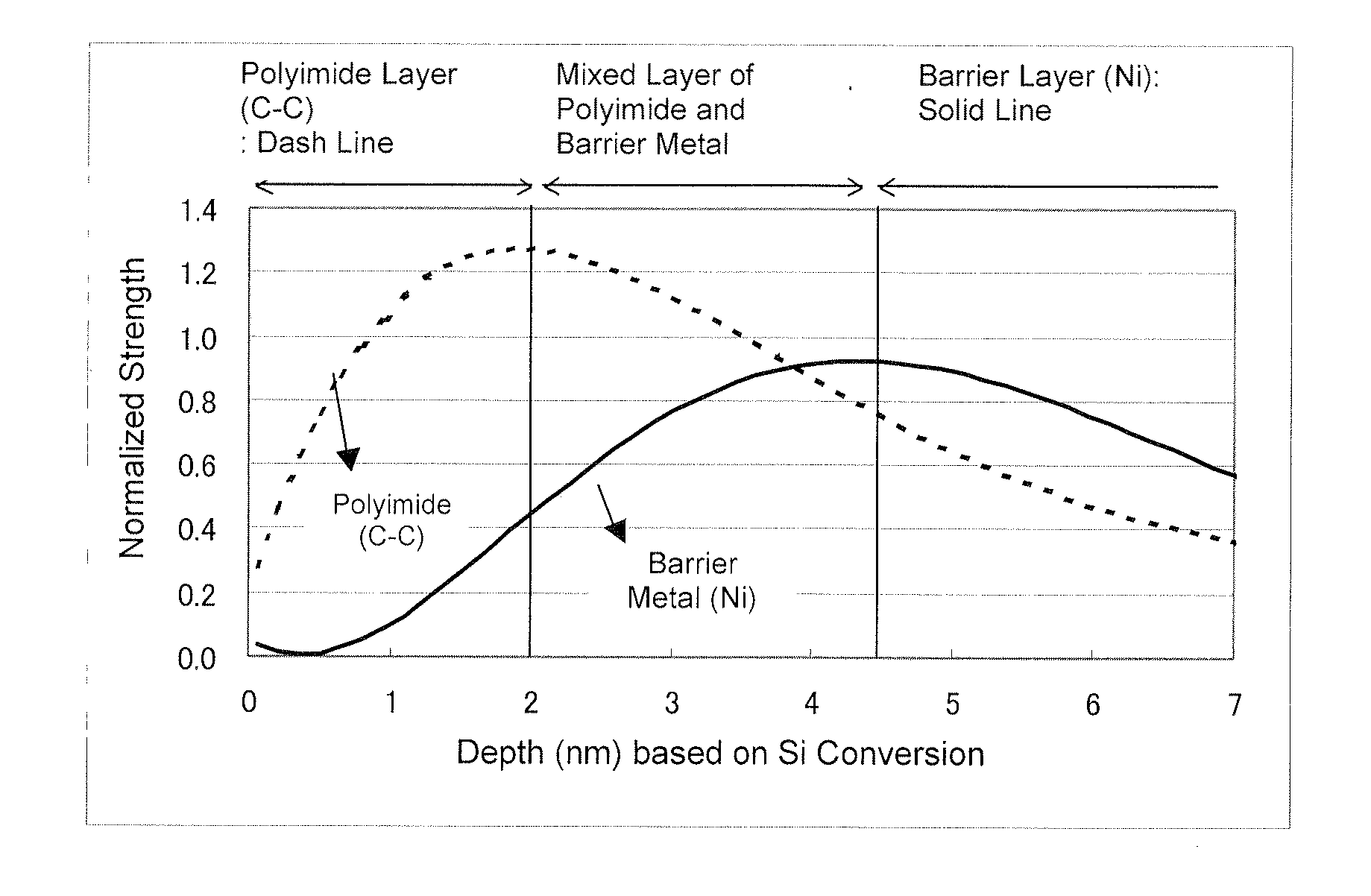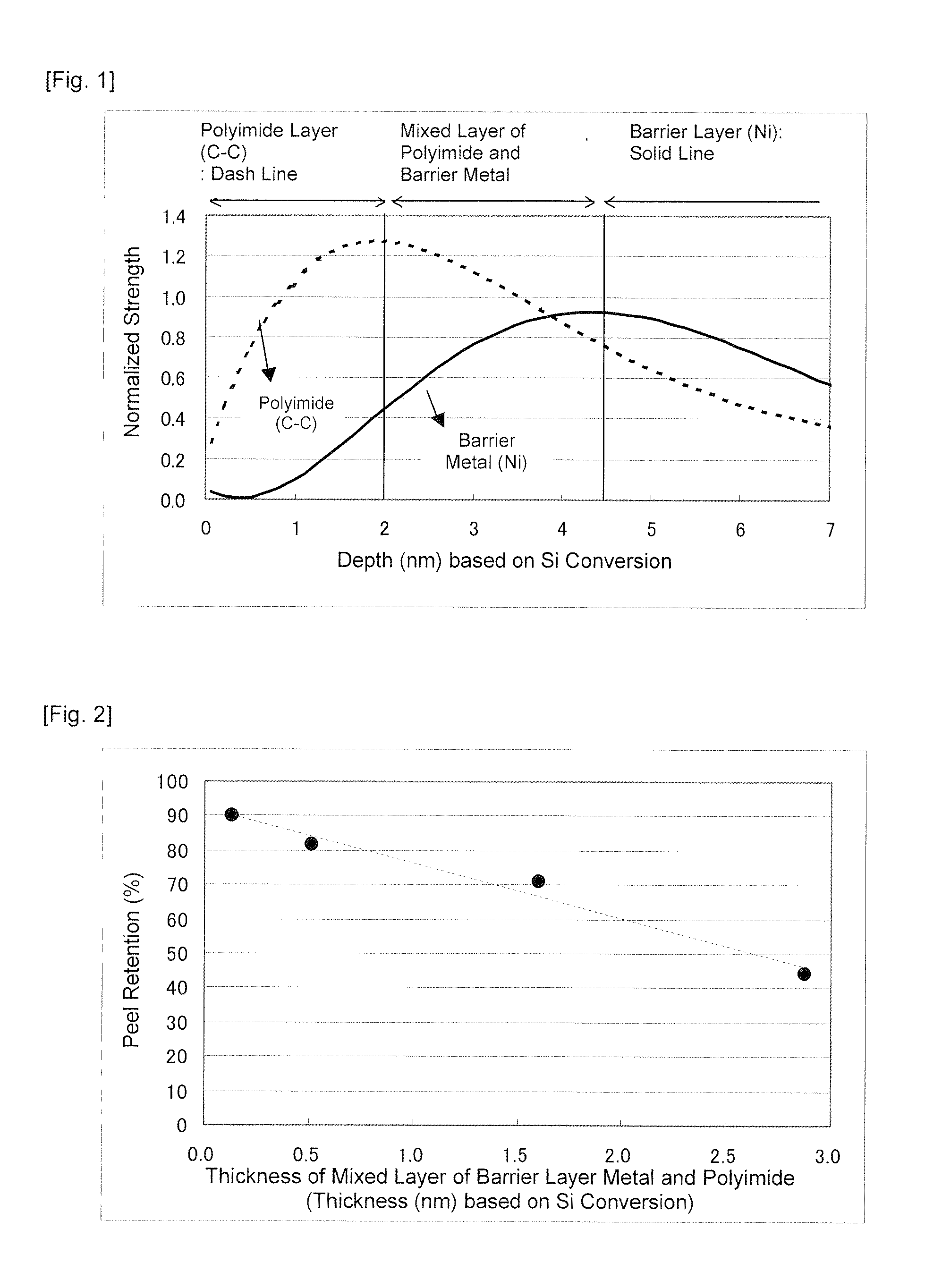Metal-Coated Polyimide Resin Substrate with Excellent Thermal Aging Resistance Properties
a technology of metal-coated polyimide resin and thermal aging resistance, which is applied in the direction of superimposed coating process, liquid/solution decomposition chemical coating, synthetic resin layered products, etc., can solve problems such as differences, and achieve the effect of increasing adhesion and superior effects in formation
- Summary
- Abstract
- Description
- Claims
- Application Information
AI Technical Summary
Benefits of technology
Problems solved by technology
Method used
Image
Examples
example 1
[0037]As the polyimide resin film, Kapton 150EN manufactured by Du Pont was used. The polyimide resin film was immersed in a potassium hydroxide solution as the surface modification process, and washed with deionized water. Subsequently, as the catalyst-adding step, the foregoing polyimide resin film was immersed in a solution in which a silane coupling agent containing a functional group with metal binding capability was mixed or reacted with a noble metal compound, and washed with deionized water.
[0038]After the foregoing treatment, as the electroless plating step, an electroless nickel-boron-based plating solution was used to form a nickel layer of 0.15 μm, this was washed with deionized water, heat treatment was thereafter performed at 150° C. to form a nickel layer of 0.05 μm, this was washed with deionized water, and a nickel layer in a total amount of 0.20 μm was formed. Subsequently, an electroless copper seed layer was formed on the nickel layer with an electroless copper p...
example 2
[0043]As the polyimide resin film, Kapton 150EN manufactured by Du Pont was used. The polyimide resin film was subject to UV irradiation and thereafter immersed in sulfuric acid as the surface modification process, and this was subsequently washed with deionized water. Subsequently, as the catalyst-adding step, the foregoing polyimide resin film was immersed in a solution in which a silane coupling agent containing a functional group with metal binding capability was mixed or reacted with a noble metal compound, and washed with deionized water.
[0044]After the foregoing treatment, as the electroless plating step, an electroless nickel-boron-based plating solution was used to form a nickel layer of 0.2 μm, this was washed with deionized water. Subsequently, an electroless copper seed layer was formed on the nickel layer with an electroless copper plating solution, and a copper conductor layer of 8 μm was thereafter formed by electroplating.
[0045]The strength on 90-degree peeling was m...
example 3
[0049]As the polyimide resin film, Kapton 150EN manufactured by Du Pont was used. The polyimide resin film was subject to UV irradiation and thereafter immersed in nitric acid as the surface modification process, and this was subsequently washed with deionized water. Subsequently, as the catalyst-adding step, the foregoing polyimide resin film was immersed in a solution in which a silane coupling agent containing a functional group with metal binding capability was mixed or reacted with a noble metal compound, and washed with deionized water.
[0050]After the foregoing treatment, as the electroless plating step, an electroless nickel-boron-based plating solution was used to form a nickel layer of 0.15 μm, this was washed with deionized water, heat treatment was thereafter performed at 150° C. to form a nickel layer of 0.05 μm, this was washed with deionized water, and a nickel layer in a total amount of 0.20 μm was formed. Subsequently, an electroless copper seed layer was formed on t...
PUM
| Property | Measurement | Unit |
|---|---|---|
| Temperature | aaaaa | aaaaa |
| Fraction | aaaaa | aaaaa |
| Fraction | aaaaa | aaaaa |
Abstract
Description
Claims
Application Information
 Login to View More
Login to View More - R&D
- Intellectual Property
- Life Sciences
- Materials
- Tech Scout
- Unparalleled Data Quality
- Higher Quality Content
- 60% Fewer Hallucinations
Browse by: Latest US Patents, China's latest patents, Technical Efficacy Thesaurus, Application Domain, Technology Topic, Popular Technical Reports.
© 2025 PatSnap. All rights reserved.Legal|Privacy policy|Modern Slavery Act Transparency Statement|Sitemap|About US| Contact US: help@patsnap.com


